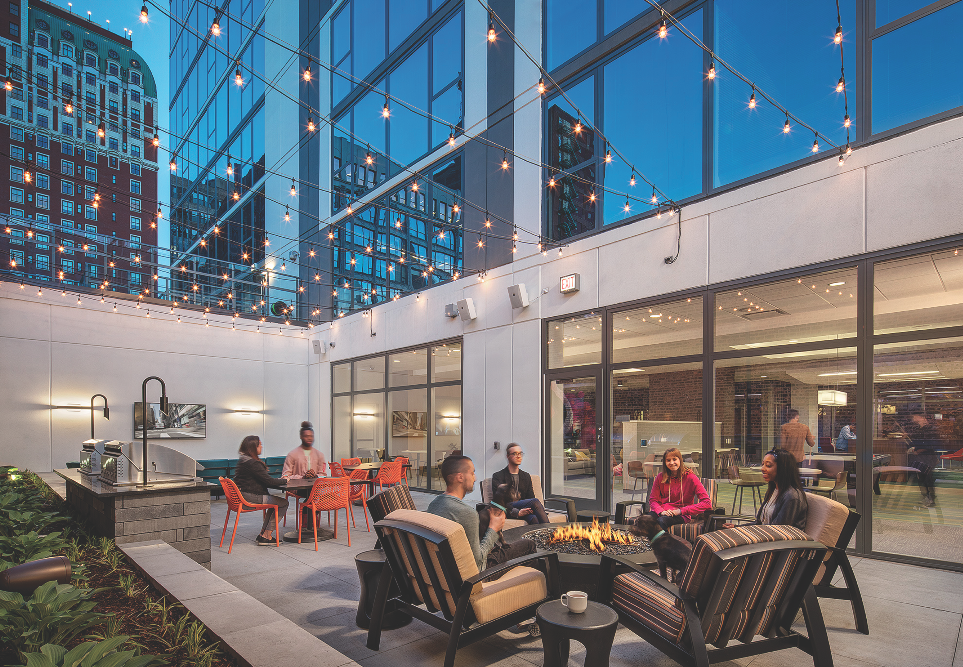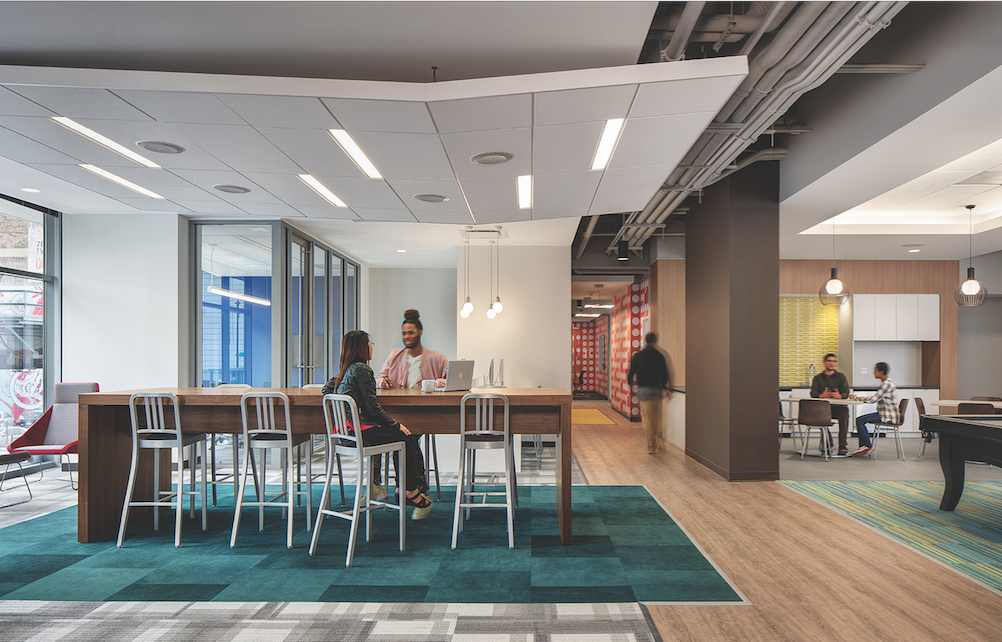An aging, diversifying U.S. population is prompting developers to shift their multifamily expansion plans to accommodate changing lifestyle preferences.
“As Millennials mature, they’re looking to invest in homes for themselves or have families,” says Daun St. Amand, AIA, LEED AP BD+C, Senior Vice President and Global Residential Sector Leader at CallisonRTKL. “In many cases, they’re moving back to the suburbs to find larger, more affordable space.”
But relocating from the city may mean a longer commute and loss of access to cultural facilities and nightlife. “The trend now is to identify suburban locations where we can design mixed-use projects that offer a bit of urbanism, including transit-oriented development and socialization opportunities,” says St. Amand.
See also: Top 150 Multifamily Architecture + AE Firms - 2018 Giants 300 rankings
See also: Top 70 Multifamily Engineering + EA Firms - 2018 Giants 300 rankings
See also: Top 70 Multifamily Construction + CM Firms - 2018 Giants 300 rankings
Sponsored by ZIP System sheathing and tape
At the same time, a growing cohort of Baby Boomers and other empty nesters are opting to downsize and relocate from suburban to urban environments, often choosing to rent instead of buy.
The National Multifamily Housing Council projects these demographic shifts will create demand for 4.6 million new apartment units by 2030.
There’s also growing demand for more affordable urban living options that will appeal to younger clientele.
Consider the 35-story Perla on Broadway condo tower under construction in downtown Los Angeles's historic theater district—the first residential high-rise built in the historic core in more than a century. Its modestly sized units and reasonable price points are intended to appeal to first-time homebuyers. It emphasizes pedestrian-oriented activities and outdoor amenity spaces such as a pool, dog walk, and active rooftop garden.
“There was a lot of thinking about each of the outdoor spaces—noise levels, socialization opportunities, and especially the ability to get away to a quiet space and decompress,” says St. Amand.
Cash-strapped Millennials looking to save on rent have a growing selection of co-living alternatives that offer tenants serviced rooms in shared apartments with communal lounges, kitchens, and bathrooms. In Chicago’s South Loop, the 30 East apartment community features 255 beds within 134 economically sized residential units.
“We are working on more projects that are incorporating the concept of renting by the bed, rather than by the unit,” says Clara Wineberg, AIA, LEED AP, Principal, Solomon Cordwell Buenz. “This building type is at an interesting intersection between student housing and urban multifamily residential projects.”
At the other end of the affordability spectrum are luxury condo towers such as the 62-story One Thousand Museum project under construction in Miami. Designed by the late Zaha Hadid, the building’s undulating exoskeleton is composed of 5,000 pieces of lightweight glass-fiber reinforced concrete imported from Dubai.
“The use of GFRC as a permanent formwork system is a first in high-rise construction, and it increases efficiency throughout the process,” says Brad Meltzer, President of Plaza Construction. This unusual construction method consists of lightweight, hollow panels that come together to form a structure core-filled with concrete and steel.

The terrace lounge at 30 East. Photo © Darris Lee Harris
“It allows the construction team to space the building’s columns up to 40 feet apart, embracing the concept of the free plan and giving residences and communal areas an open look and feel,” says Meltzer.
Lendlease reports a growing demand for complex multifamily designs that feature sloping walls, high slab heights, and large floor-to-ceiling views.
In New York City’s Tribeca neighborhood, the newly opened 56 Leonard Street condominium development features atypical floor plates, cantilevered floors, and irregular balcony spacing. Each of the building’s 146 condo units is equipped with its own private outdoor space, but the unusual layout of each floor created significant logistical challenges for the construction team.
“We had to bring a unique strategy to the project and reposition all of our equipment on each floor when pouring the concrete,” says Jeff Arfsten, Managing Director and Chief Operating Officer with Lendlease Americas. “Through these innovative designs, developers are able to provide residents with superior and unique living experiences to meet their evolving needs.”
GROWING—and changing—IN PLACE
Tenants are looking for flexible living spaces and the ability to personalize their home environment. NMHC's 2018 Consumer Housing Insights Survey found that 83% of respondents believed it’s important to have a space that evolves through different stages of their lives; 78% said it’s important to have a space that can change to meet changing needs.
“We’re starting to design residential units differently than we have in the past, because we want to aid that ability to personalize the space and use it differently as time goes on,” says St. Amand.
These units might integrate side-by-side living spaces with a sliding wall that can be reconfigured into an open environment, or “plus one” space that can be converted into a temporary bedroom or workroom.
There’s also a move toward encouraging socialization among tenants via active lobbies, expanded food and beverage offerings, and numerous activity spaces.
“If you have friends in the building, you’re more likely to renew your lease, and renewing leases is a major part of making pro formas work,” says St. Amand.
Some of today’s most popular amenities emphasize convenience, such as built-in vestibules or valet closets to accommodate package deliveries right at the unit rather than in centralized lockers near the lobby.
“Another trend we’re seeing is the use of smart appliances, locks, and outlets that can be controlled remotely,” says Lendlease's Arfsten. “In prior years, you would see this technology only used in condominiums, but now it’s increasingly used throughout rental properties.”
Architects and engineers are also starting to incorporate drone landing pads and security in preparation for the use of drones for transporting not only packages, but even people.
“Given that drone transportation is not yet fully developed or legally approved, it poses an opportunity for us to solve this anticipated innovation for the industry,” says Mark Humphreys, CEO, Humphreys & Partners Architects.
Related Stories
| Aug 11, 2010
Luxury high-rise meets major milestone
A topping off ceremony was held in late October for 400 Fifth Avenue, a 57,000-sf high-rise that includes a 214-room luxury hotel and 190 high-end residential condominiums. Developed by Bizzi & Partners Development and designed by Gwathmey Siegel & Associates Architects, the 60-story tower in midtown Manhattan sits atop a smaller-scale 10-story base, which creates a street façade t...
| Aug 11, 2010
Mixed-use Seattle high-rise earns LEED Gold
Seattle’s 2201 Westlake development became the city’s first mixed-use and high-rise residential project to earn LEED Gold. Located in Seattle’s South Lake Union neighborhood, the newly completed 450,000-sf complex includes 300,000 sf of Class A office space, 135 luxury condominiums (known as Enso), and 25,000 sf of retail space.
| Aug 11, 2010
Triangular tower targets travelers
Chicago-based Goettsch Partners is designing a new mixed-use high-rise for the Chinese city of Dalian, located on the Yellow Sea coast. Developed by Hong Kong-based China Resources Land Limited, the tower will have almost 1.1 million sf, which includes a 377-room Grand Hyatt hotel, 84 apartments, three restaurants, banquet space, and a spa and fitness center.
| Aug 11, 2010
Brooklyn's tallest building reaches 514 feet
With the Brooklyner now topped off, the 514-foot-high apartment tower is Brooklyn's tallest building. Designed by New York-based Gerner Kronick + Valcarcel Architects and developed by The Clarett Group, the soaring 51-story tower is constructed of cast-in-place concrete and clad with window walls and decorative metal panels.
| Aug 11, 2010
RMJM unveils design details for $1B green development in Turkey
RMJM has unveiled the design for the $1 billion Varyap Meridian development it is master planning in Istanbul, Turkey's Atasehir district, a new residential and business district. Set on a highly visible site that features panoramic views stretching from the Bosporus Strait in the west to the Sea of Marmara to the south, the 372,000-square-meter development includes a 60-story tower, 1,500 resi...
| Aug 11, 2010
'Feebate' program to reward green buildings in Portland, Ore.
Officials in Portland, Ore., have proposed a green building incentive program that would be the first of its kind in the U.S. Under the program, new commercial buildings, 20,000 sf or larger, that meet Oregon's state building code would be assessed a fee by the city of up to $3.46/sf. The fee would be waived for buildings that achieve LEED Silver certification from the U.
| Aug 11, 2010
Colonnade fixes setback problem in Brooklyn condo project
The New York firm Scarano Architects was brought in by the developers of Olive Park condominiums in the Williamsburg section of Brooklyn to bring the facility up to code after frame out was completed. The architects designed colonnades along the building's perimeter to create the 15-foot setback required by the New York City Planning Commission.
| Aug 11, 2010
U.S. firm designing massive Taiwan project
MulvannyG2 Architecture is designing one of Taipei, Taiwan's largest urban redevelopment projects. The Bellevue, Wash., firm is working with developer The Global Team Group to create Aquapearl, a mixed-use complex that's part of the Taipei government's "Good Looking Taipei 2010" initiative to spur redevelopment of the city's Songjian District.
| Aug 11, 2010
Recycled Pavers Elevate Rooftop Patio
The new three-story building at 3015 16th Street in Minot, N.D., houses the headquarters of building owner Investors Real Estate Trust (IRET), as well as ground-floor retail space and 71 rental apartments. The 215,000-sf mixed-use building occupies most of the small site, while parking takes up the remainder.
| Aug 11, 2010
Housing America's Heroes 7 Trends in the Design of Homes for the Military
Take a stroll through a new residential housing development at many U.S. military posts, and you'd be hard-pressed to tell it apart from a newer middle-class neighborhood in Anywhere, USA. And that's just the way the service branches want it. The Army, Navy, Air Force, and Marines have all embarked on major housing upgrade programs in the past decade, creating a military housing construction boom.







